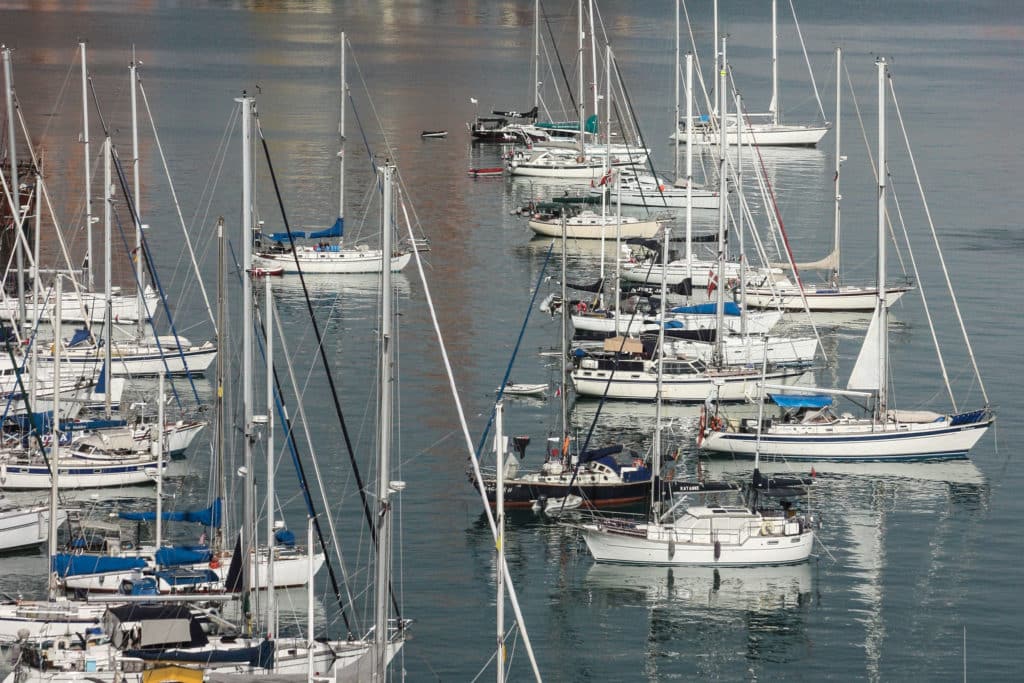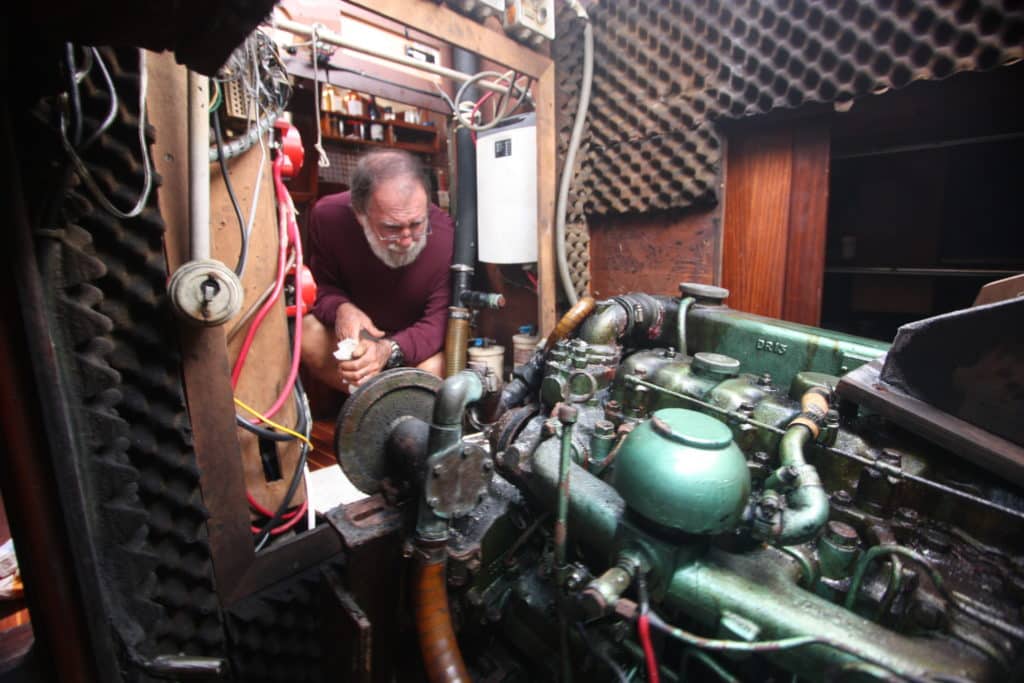
I am a believer in modern marine diesels. If you buy a new one, religiously maintain it, and never run it hot or without oil, it will last practically forever. The first thing I did when I purchased Ganesh, our 43-foot Wauquiez Amphitrite, was toss away the 35-year-old Perkins and slip in a brand-new Perkins. Given a small cruising kitty, I’d much rather have an old boat with a new engine than vice versa. As you can see, I am emphatically pro-engine on cruising sailboats.
However, I’ve gone long spans of time engineless, on various sailboats, including the 22-foot Corina, the 35-foot Carlotta and the 38-foot Wild Card. Why? Because, as much as I love a dependable diesel, I absolutely loathe an undependable one. There is nothing worse than an engine that runs just long enough to get you into serious trouble — and then deserts you.
Thus I’ve cruised with no engine while saving up my freedom chips to buy a brand-new one. Why not buy a rebuilt engine that is as good as new? Simply put, because it is not. If such engines were, the dealers would warranty them the same, but they don’t. Most rebuilt engines come with a taillight warranty: It lasts about as long as you can see the mechanic’s taillights burning rubber out of the shipyard. Do I sound bitter? I learned this lesson the hard way.
Take our salvaged Wild Card, for instance. While I did manage to get its two-lunger diesel to run a bit after Hurricane Hugo, it ran only long enough to convince me to spend ever more money on it. Once I realized it wasn’t ever going to be dependable, I gave it away to a masochistic mechanic and went five years, from 1990 to 1995, sailing without an engine.
We extensively cruised the windy West Indies, from Venezuela and Trinidad to Puerto Rico every year, and attended nearly every regatta in the eastern Caribbean, all sans diesel.
The best part was getting together with the likes of Don Street of Iolaire, John Smith of Mermaid of Carriacou, or Julian Davies of Tiger Maru. We’d always manage, regardless of our limited pennies, to get hit by a drunk front with embedded rum squalls, and howl at each other, “Would you disgrace your vessel with a stinking, oil-oozing piece of metal crap? Never!”
Being engineless certainly had its lighthearted moments. Once a bareboat charterer told me to stop hot-dogging as I sailed through the anchorage at Norman Island in the British Virgins. I immediately anchored and confessed to him that I’d just purchased the boat and didn’t know how to start my engine. Hell, I told him, I couldn’t even find it! Being a fine fellow, he swam over to help, and we had a pleasant hour or two drinking Mount Gay and hunting for our elusive prey. Finally, the guy borrowed a mask, dived overboard, looked at my boat’s completely smooth underbody devoid of a prop, and said, “Oh, you got screwed!”
Things got even better when I installed my Bose cockpit speakers and recorded a cassette tape of an engine starting, warming up and running smoothly. Whenever there was a lull in one of our massive raft-up parties, I’d just loudly announce that I was going to crank up to charge my batteries, then punch my play button belowdecks and shout out the hatch, “Can somebody check and see if my raw-water is pumping?”
When you’re dead broke in the Caribbean, you have to find your amusements any way you can. We enjoyed endless variations on that theme. We’d casually toss swimmers a rusty putty knife or scraper and ask, “While you’re in the water, could you knock the barnacles off the prop?” Some folks would still be circling our vessel if we hadn’t taken pity and let them in on the joke.
One swimmer with a good buzz on quickly reported that we had no prop. My jaw dropped in amazement. I said, “I hope you’re joking!” while my wife, Carolyn, dashed up from the galley screaming, “Not the prop pirates again!”
“Yeah,” said the amazed guy in the water, “and I guess they got the shaft too!”
Being engineless, however, is not all fun and games. Our mooring in Great Cruz Bay, at St. John in the U.S. Virgins, was cheek-to-jowl with other vessels. While the Sparkman & Stephens-designed Wild Card handled beautifully, and we never damaged ourselves or another vessel, the owners of nearby Hinckleys and other well-polished yachts died of coronaries long before their time. Carolyn didn’t seem to enjoy it as much as I did. A number of times, as we zigzagged under sail through the crowded mess, Carolyn screamed aft, “Fatty, hit a cheap one, OK?”
The tolerance among the spectators for such shenanigans became sort of a barometer of sea-gypsy acceptance. Once, in Puerto Rico at a fancy new resort marina, after flawlessly sailing up to a fuel dock to take on water, the dock jockey went off on us for even attempting it.
“Are you crazy?” he asked me.
“Where did you hear that?” I asked. “Did my therapist call? Damn that woman!”
A few months later, in the Lesser Antilles, when I pulled the same stunt in St. Maarten at Bobby’s Marine, the West Indian harbormaster watched, smiled and said, “Ya mon, sweet!”

The main lesson I learned about close-quarter work under sail was this: If you think you can, you can. If you think you can’t, you can’t. I say this not to encourage anyone to take a foolish chance, but to caution you that if you don’t think you’re up to the challenge, you’re definitely not — and shouldn’t even try. The key to sailing without an engine year after year and not damaging anything is to have the wisdom not to attempt what you shouldn’t.
Sailing off our crowded mooring was easy. We’d just reverse our position on the mooring by walking the pendant line astern without casting off. Once we were stern to the wind and completely ready, we’d just cast off, pop open the roller-furling jib, and slalom out with complete control. Easy as pie.
If we came back in settled conditions with a crew — after a race, for instance — I’d just go for it. The only problem was having enough way on to fetch the pendant, and yet not so much speed that we overshot the mooring.
This is easy when it works. But a sudden lull or gust at the last moment can make it messy. There was always that do-it-or-abort moment that would make me shake with fear.
If it was just Carolyn and I approaching the mooring, I’d often luff up and put Carolyn in our little rowing dinghy with a length of thick polypropylene line that had a large fender tied at one end. She would row over and attach the line to the mooring pendant and then let the fender drift backward in the breeze. This made picking up the mooring easy, as the floating bright-yellow line extended downwind almost to the next mooring buoy. Once Carolyn was back on the sailboat, I’d swoop us in and bring Wild Card up alongside the polypro as Carolyn used our boathook to scoop it up and quickly attached a strong stainless-steel snap shackle around it. The shackle was tied to a line that ran from the bow cleat over the anchor roller. Presto! We’d be attached to the mooring without any chance of coming undone.
Once she’d yelled aft, “Made!” she’d pull the shackle aboard, along with as much slack in the polypro as possible, and belay it around the cleat. The beauty of this method was that once the snap shackle was attached, there couldn’t be an unexpected line fumble while routing the polypro around the forestay or bow rail. We were secure, and the boat couldn’t suddenly become loose without steerage in close quarters.
When we did it right, the boat would have very little way by the time we had the mooring line in hand. I’d just fully luff the sails and then dash forward to drop the mainsail as all forward motion ceased. It helped that I’d converted Wild Card from wheel to tiller steering; the boat was easy to slow using excessive rudder drag created when I’d first put the helm hard over on one side, then the other.
To wrap things up, I’d drop our mooring splice over our bitts at my leisure and re-coil the polypro for future use.
This method worked well unless it was too squally. Then we’d just anchor outside the open-mouthed harbor and push Wild Card in with the dinghy, at night, when the trades lay down a bit.
Often, instead of docking or attempting to raft up under sail, we’d just sail up and anchor to windward of the dock or raft-up, and then pay out scope on the 300-foot, 3⁄8-inch nylon rode we carried specifically for this purpose. In its day, our handling of a Danforth 12H was a mighty beautiful thing.
Eventually, though, being engineless got old. We actively cruise and live aboard our boat. It’s where we earn our money. We use it to fetch supplies and enter races; it’s our means of interisland transportation, and we like to party aboard. When the crews aboard the other boats grew tired, they hit the starter button. For us, the most stressful part of attending Antigua Sailing Week was picking up our Cruz Bay mooring upon our return. I remember the straw that broke the camel’s back. I’d taken part in the BVI Spring Regatta. I had a swell time racing, had a blast at the lively awards ceremony, and managed to sail out of Tortola’s Nanny Cay (yeah, tricky) as a fat moon rose — and took away the last breath of wind.
I was dead in the water, but that wasn’t my concern. The problem was that my wife and young daughter were waiting for me on the beach at Great Cruz Bay and were being eaten by mosquitoes and no-see-ums. They were not happy, not even when they finally sighted my tricolor entering the harbor after midnight.
Luckily, this shameful moment coincided with our reaching the magic $5,000 mark in our engine fund. We slapped in a Perkins M30 in 1995. It was and is a wonderful diesel engine and is still running for the boat’s new owners.
Today I’m older and wiser, and our new boat doesn’t handle as if controlled by my every whim. I would never consider cruising without an engine on Ganesh, although I regularly sail her into harbors just to keep in touch with my daredevil roots. But there’s no doubt being engineless taught me a thing or two about both sailing and grace under pressure. And, even worse, I must admit that I miss the childish thrill of roaring past all the mega-yachts in St. Barts to luff up within sight of Lulu’s Marine, screaming at the top of my lungs, “Does anyone know how to get these white floppy things down?!”
Fatty and Carolyn Goodlander are enjoying cruising Asian-style aboard their repowered ketch, Ganesh.








